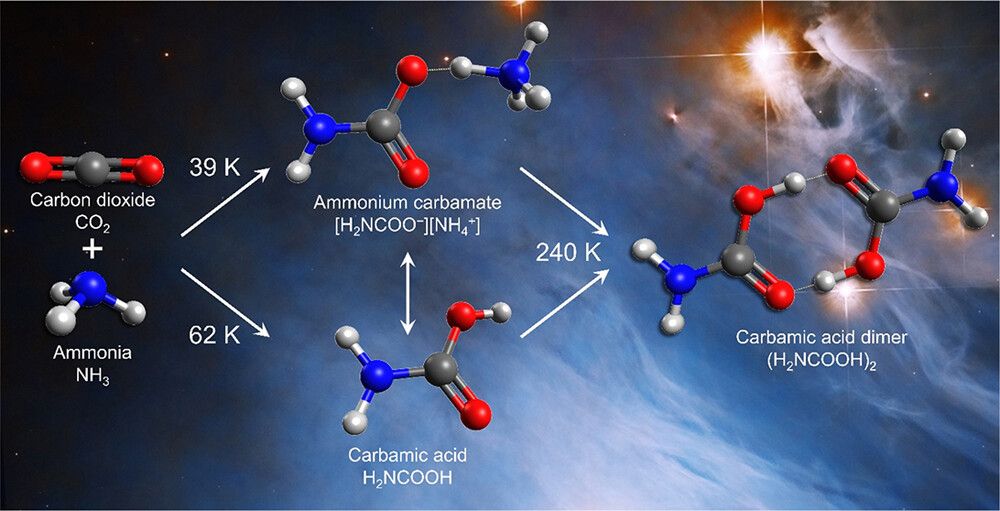The Origins of Life as We Know It Might Trace Back to an Ancient, Frigid Cosmic Cloud
An amino acid has been produced in a lab by warming analogs of ices found in the freezing conditions of interstellar gas clouds.
New laboratory experiments demonstrate that amino acids can originate in the frigid conditions of interstellar molecular gas clouds, providing additional support for the hypothesis that the fundamental building blocks of life on Earth originated in space. Scientists, led by researchers at the University of Hawaii at Manoa and the National Dong Hwa University in Taiwan, mimicked interstellar ices by freezing carbon dioxide and ammonia, substances commonly found in the cold molecular gas clouds associated with star formation. Gradually warming these ices to 62 kelvin (–211 degrees Celsius or –348 degrees Fahrenheit) led to the creation of carbamic acid, a simple amino acid with biochemically significant roles.
Carbamic acid can link with phosphate units to form molecules like carbamoyl phosphate, playing a crucial role in the urea cycle and serving as a precursor to various nucleobases and other amino acids—essential components of proteins. The research strengthens the proposition that life’s basic constituents, including amino acids, sugars, proteins, and potentially more complex organic molecules, originated in space and were subsequently transported to Earth.
Senior author Ralf Kaiser of the University of Hawaii emphasized the possibility of amino acid formation in cold molecular clouds, as evidenced by their laboratory experiments. Previous discoveries of amino acids in meteorites, comets, and samples returned from asteroids align with the theory that these essential compounds predate Earth’s formation. While past experiments generated amino acids through ionizing radiation from galactic cosmic rays, the latest results reveal that amino acids can form even without such radiation, establishing lower temperature limits for their formation.
Although amino acids haven’t been directly detected in interstellar molecular clouds, the study provides crucial insights. The findings indicate that carbamic acid and ammonium carbamate, also produced in the experiment, can transition to stable gases as molecular clouds warm due to the energy emitted by emerging young stars. This transition to the gas phase makes detection feasible with radio telescopes, including the Atacama Large Millimeter/submillimeter Array (ALMA) in Chile. Detecting amino acids in regions busy forming asteroids and protoplanets, such as protoplanetary discs imaged by ALMA, would further affirm the theory that amino acids originate in molecular clouds associated with star and planet formation and later become integrated into planetary bodies.

Currently, Kaiser states that the subsequent objectives involve replicating the synthesis of additional organic compounds under conditions simulating interstellar clouds and regions where stars form.
“One potential avenue is to explore whether more intricate bio-organic molecules can be generated through laboratory experiments,” he remarked. In a recent study, Kaiser and his team created a chelating agent using a combination of ammonia and acetaldehyde ices. A chelating agent forms bonds with ions, including “metal ions” like magnesium, potassium, and sodium. In cellular biology, this process is vital for transporting ions across cell membranes, usually requiring highly intricate molecules to facilitate these functions—molecules whose formation in space remains uncertain.
Nevertheless, Kaiser notes that their experiment produced a more fundamental molecule, and he states, “The prebiotic chelating agent formed from ammonia and acetaldehyde provides a very simple and versatile pathway, similar to carbamic acid, to form more complex systems in space.”
As evolutionary biologists trace the progression of biochemistry on Earth and astronomers advance in comprehending the formation of increasingly intricate organic molecules utilized by life in space, the convergence of these investigations edges closer. This convergence holds the promise of shedding light on the origin of life on Earth and, potentially, elsewhere in the cosmos.
The findings were published on Nov. 29 in the journal ACS Central Science.
Do not forget to share your opinion with us to provide you with the best posts !




0 Comments